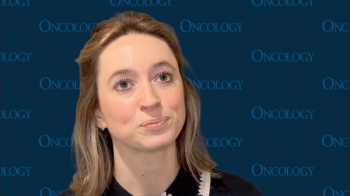
MYC-Rearrangement Affects Prognosis 2 Years Post-DLBCL Diagnosis
MYC-rearrangement within 2 years after diagnosis may affect the prognosis of patients with diffuse large B-cell lymphoma.
Patients with
Andreas Rosenwald, MD, of University of Würzburg and Comprehensive Cancer Center Mainfranken, Würzburg, Germany, and colleagues conducted this study to examine if the impact of MYC rearrangement on prognosis was influenced by the MYC partner gene (IG or a non-IG gene).
“The routine work-up of aggressive B-cell non-Hodgkin lymphoma at many institutions now includes FISH testing for MYC-rearrangement and, if positive, for BCL2 and BCL6 loci,” they wrote.
However, many questions about the role of
The study looked at 5,117 patients with DLBCL taken from large prospective trials and patient registries in Europe and North America. All patients were treated with rituximab plus cyclophosphamide, doxorubicin, vincristine, and prednisone, or a similar treatment regimen.
Of the included patients, 47% had biopsy material sufficient for assessment of MYC-rearrangement. Among those patients, 11% had MYC-rearrangement, and this rearrangement was associated with significantly shorter progression-free survival (PFS) and overall survival (OS).
The researchers noted a time-dependent effect on outcome for patients with MYC-rearrangement, with the strongest effect occurring within the first 2 years after diagnosis; beyond the first 2 years, the negative effect of MYC- rearrangement was not noted.
“Thus, the survival probability of patients with MYC-rearrangement DLBCL who survived for at least 2 years did not differ from those with DLBCL without MYC-rearrangement,” the researchers wrote.
The adverse effect of MYC-rearrangement was only found in patients with a concurrent rearrangement of BCL2 and/or BCL6 and an IG partner (HR=2.4; 95% CI, 1.6–3.6; P<.001). This effect was most evident in the first 2 years after diagnosis (PFS: HR=2.9; 95% CI, 2.0–4.3 and OS:HR=3.6; 95% CI, 2.5–5.4).
This finding may have two significant implications, according to the researchers.
“First, future FISH strategies in DLBCL may have to include the IG lightchain loci in cases where MYC is rearranged, and second, risk-adjusted therapeutic approaches in DLBCL may be needed only for MYC-DH/TH cases in which MYC is rearranged to an IG partner,” they wrote.
In addition, because these negative effects seem to be limited to the first 2 years after diagnosis, the researchers recommended that “emphasis should be given to optimizing first-line treatment and consolidation after complete remission.”
Newsletter
Stay up to date on recent advances in the multidisciplinary approach to cancer.

















































































